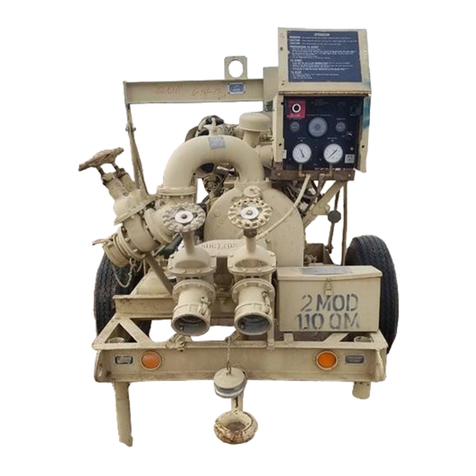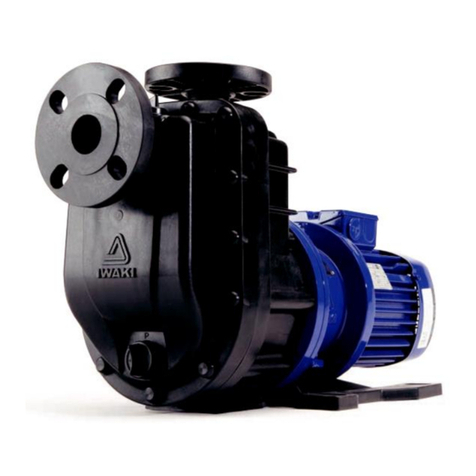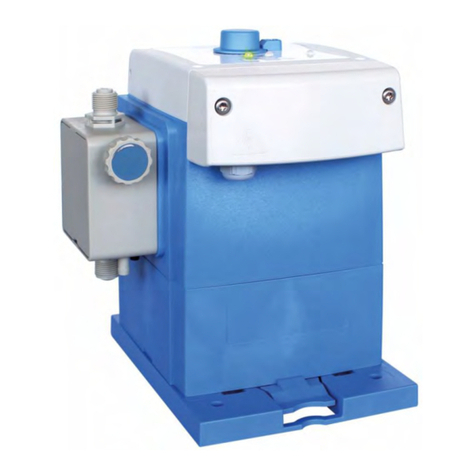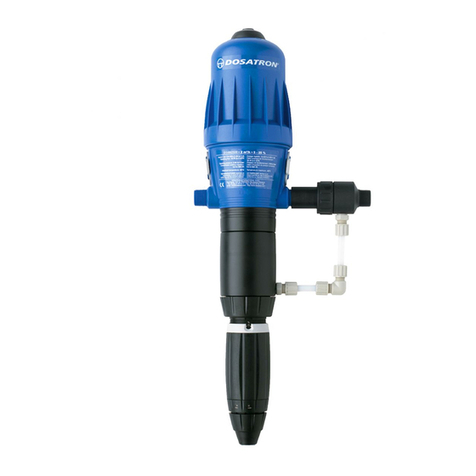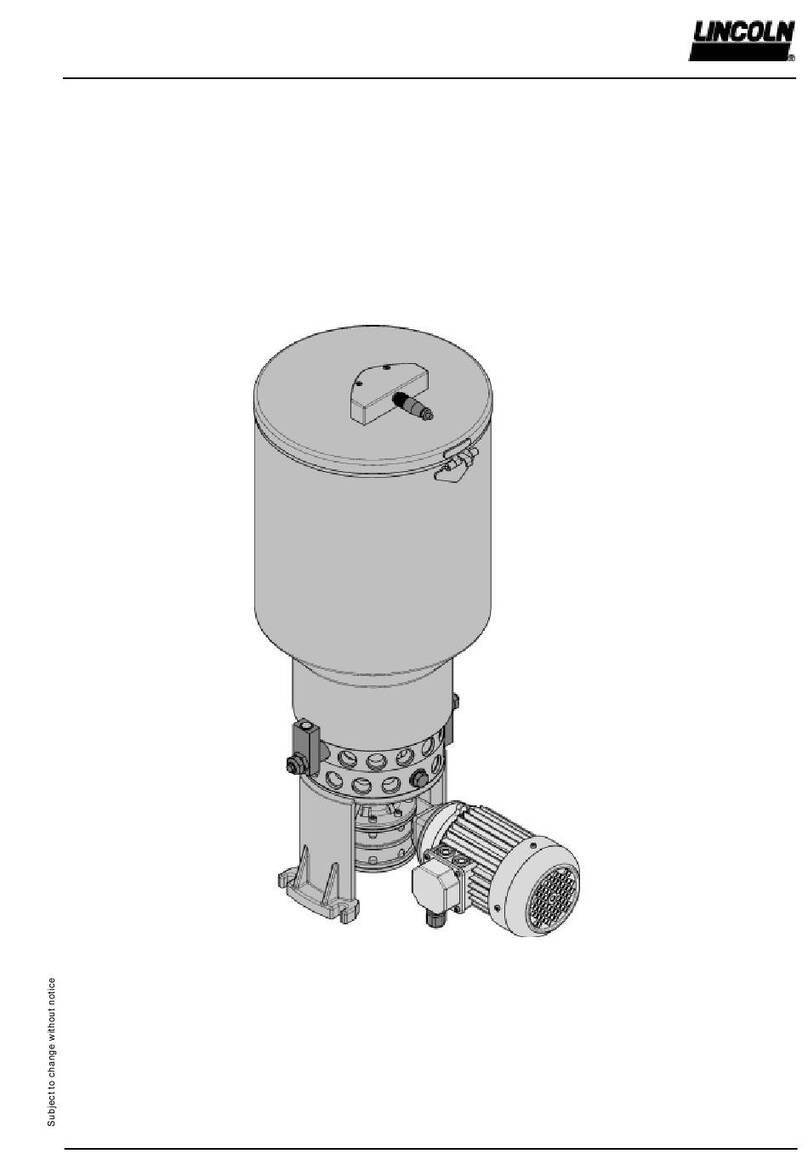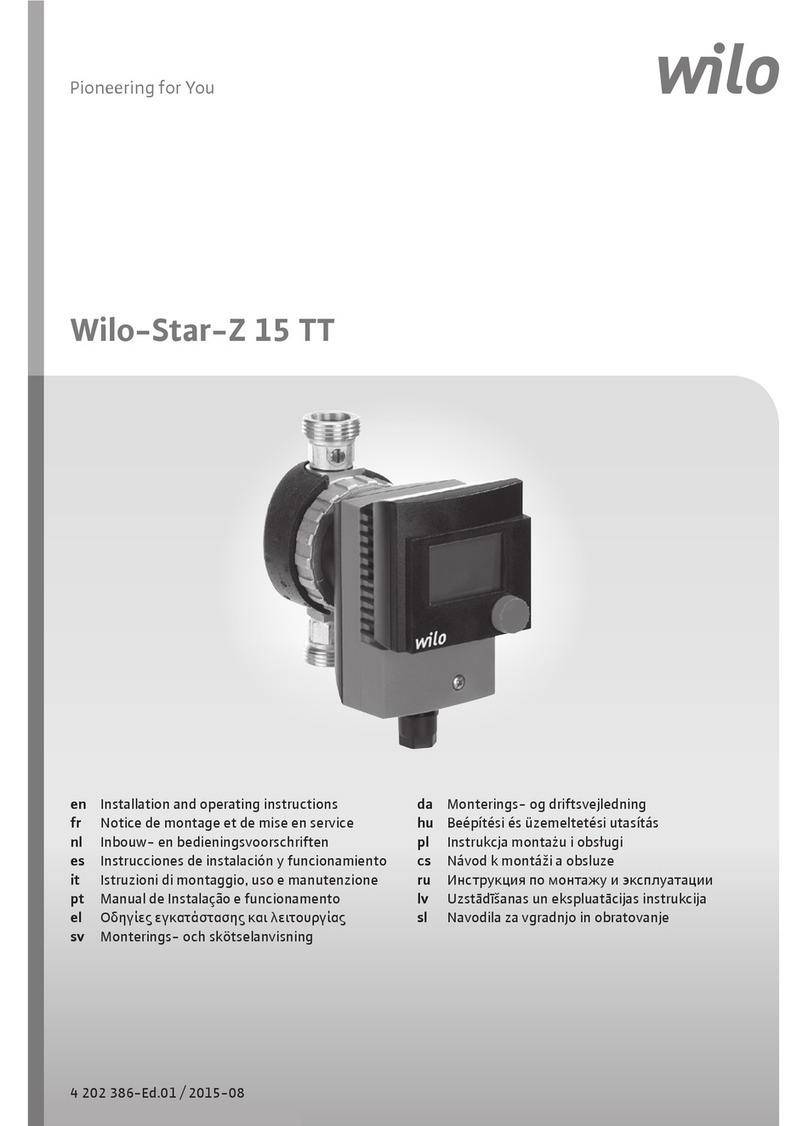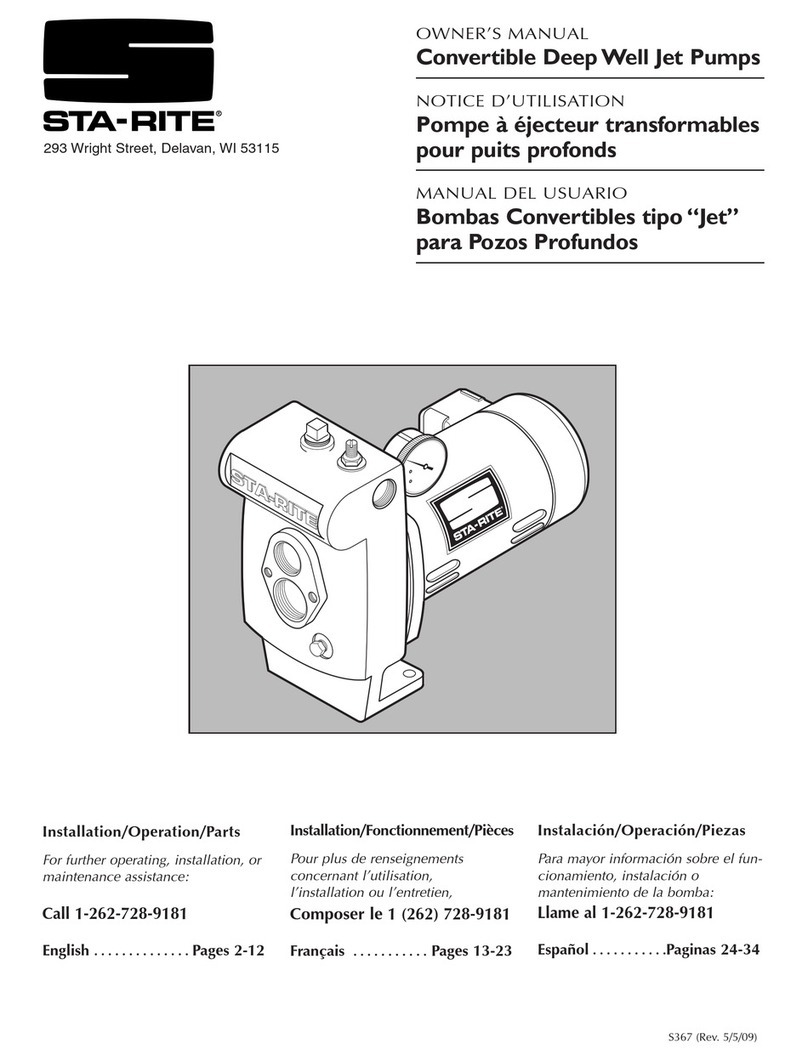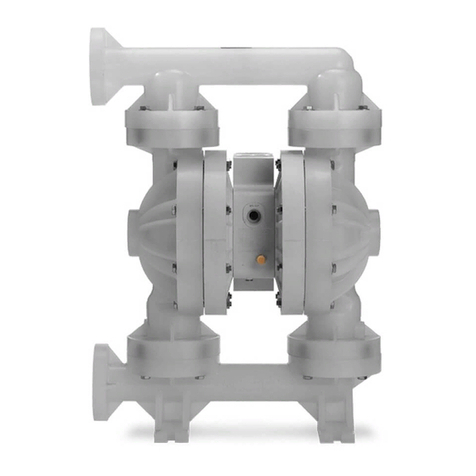GR PA Series User manual

OM-06704-03
November 19, 2014
GORMAN‐RUPP PUMPS
www.grpumps.com
2014 Gorman‐Rupp Pumps Printed in U.S.A.
INSTALLATION, OPERATION,
AND MAINTENANCE MANUAL
WITH PARTS LIST
PA SERIESPUMP
MODEL
PA10A60-B-E100 3P

Register your new
Gorman‐Rupp pump online at
www.grpumps.com
Valid serial number and e‐mail address required.
RECORD YOUR PUMP MODEL AND SERIAL NUMBER
Please record your pump model and serial number in the
spaces provided below. Your Gorman‐Rupp distributor
needs this information when you require parts or service.
Pump Model:
Serial Number:

TABLE OF CONTENTS
i
INTRODUCTION PAGE I - 1.................................................
SAFETY ‐ SECTION A PAGE A - 1............................................
INSTALLATION - SECTION B PAGE B - 1....................................
Pump Dimensions PAGE B - 1.....................................................
PREINSTALLATION INSPECTION PAGE B - 2............................................
POSITIONING PUMP PAGE B - 2.......................................................
Lifting PAGE B - 2.................................................................
Mounting PAGE B - 2.............................................................
SUCTION AND DISCHARGE PIPING PAGE B - 3.........................................
Materials PAGE B - 3..............................................................
Line Configuration PAGE B - 3......................................................
Connections to Pump PAGE B - 3..................................................
Gauges PAGE B - 3...............................................................
SUCTION LINES PAGE B - 3...........................................................
Fittings PAGE B - 3...............................................................
Strainers PAGE B - 3..............................................................
Sealing PAGE B - 3...............................................................
Suction Lines In Sumps PAGE B - 3.................................................
Suction Line Positioning PAGE B - 4................................................
DISCHARGE LINES PAGE B - 4........................................................
Siphoning PAGE B - 4.............................................................
Valves PAGE B - 5................................................................
ELECTRICAL CONNECTIONS PAGE B - 5...............................................
Grounding Methods PAGE B - 5....................................................
Field Wiring Connections (Incoming Power) PAGE B - 6...............................
Voltage Imbalance PAGE B - 6.....................................................
Power Cable Connections PAGE B - 6...............................................
Control Box Adjustment PAGE B - 7.................................................
ALIGNMENT PAGE B - 7..............................................................
AUTO‐START PAGE B - 7.............................................................
Float Switch Installation PAGE B - 7.................................................
Submersible Transducer Installation PAGE B - 8......................................
Transducer Connections PAGE B - 10................................................
OPERATION - SECTION C PAGE C - 1......................................
STARTING AND OPERATION PAGE C - 1...............................................
Control Box Function PAGE C - 1...................................................
Component Function PAGE C - 1...................................................
Rotation PAGE C - 2..............................................................
Priming PAGE C - 2...............................................................
Leakage PAGE C - 2..............................................................
Pump Vacuum Check PAGE C - 2..................................................
Priming Chamber Discharge Line PAGE C - 3........................................
Liquid Temperature And Overheating PAGE C - 3.....................................
Strainer Check PAGE C - 3.........................................................
STOPPING PAGE C - 3................................................................

TABLE OF CONTENTS
(continued)
ii
Manual Stopping PAGE C - 3.......................................................
Automatic Stopping PAGE C - 3....................................................
PERIODIC CHECKS PAGE C - 3.......................................................
Seal and Bearing Cavity Lubrication PAGE C - 3......................................
Bearing Temperature Check PAGE C - 3.............................................
Air Compressor PAGE C - 4........................................................
COLD WEATHER PRESERVATION PAGE C - 4...........................................
TROUBLESHOOTING - SECTION D PAGE D - 1..............................
PREVENTIVE MAINTENANCE PAGE D - 3...............................................
PUMP MAINTENANCE AND REPAIR ‐ SECTION E PAGE E - 1.................
STANDARD PERFORMANCE CURVE PAGE E - 1........................................
PARTS LISTS:
Pump Model PAGE E - 3..........................................................
Pump Model Assembly PAGE E - 5.................................................
Pump End Assembly PAGE E - 7...................................................
Priming Chamber Kit PAGE E - 8...................................................
Priming Chamber Assembly PAGE E - 9.............................................
PUMP AND SEAL DISASSEMBLY AND REASSEMBLY PAGE E - 10.........................
Priming Chamber Removal and Disassembly PAGE E - 11..............................
Discharge Check Valve Removal and Disassembly PAGE E - 11.........................
Suction Spool Flange Removal PAGE E - 11..........................................
Suction Head and Wear Ring Removal PAGE E - 12....................................
Separating Pump End From Power Source PAGE E - 12................................
Loosening Impeller PAGE E - 12.....................................................
Pump Casing Removal PAGE E - 13.................................................
Impeller Removal PAGE E - 13......................................................
Seal Removal PAGE E - 13..........................................................
Shaft and Bearing Removal and Disassembly PAGE E - 13.............................
Shaft and Bearing Reassembly and Installation PAGE E - 14............................
Securing Pump End to Power Source PAGE E - 15....................................
Seal Reassembly and Installation PAGE E - 15........................................
Impeller Installation and Adjustment PAGE E - 16......................................
Pump Casing Installation PAGE E - 17................................................
Suction Head and Wear Ring Installation and Adjustment PAGE E - 17...................
Suction Spool Flange Installation PAGE E - 17.........................................
Priming Chamber Assembly and Installation PAGE E - 18...............................
Discharge Check Valve Reassembly PAGE E - 18......................................
LUBRICATION PAGE E - 18.............................................................
Seal Assembly PAGE E - 18.........................................................
Bearings PAGE E - 18..............................................................

PA SERIES OM-06704
PAGE I - 1INTRODUCTION
INTRODUCTION
Thank You for purchasing a Gorman‐Rupp pump.
Read this manual carefully to learn how to safely
install and operate your pump. Failure to do so
could result in personal injury or damage to the
pump.
Because pump installations are seldom identical,
this manual cannot possibly provide detailed in
structions and precautions for every aspect of
each specific application. Therefore, it is the re
sponsibility of the owner/installer of the pump to
ensure that applications not addressed in this
manual are performed only after establishing that
neither operator safety nor pump integrity are com
promised by the installation. Pumps and related
equipment must be installed and operated ac
cording to all national, local and industry stan
dards.
If there are any questions regarding the pump or
its application which are not covered in this man
ual or in other literature accompanying this unit,
please contact your Gorman‐Rupp distributor, or
The Gorman‐Rupp Company:
The Gorman‐Rupp Company
P.O. Box 1217
Mansfield, Ohio 44901-1217
Phone: (419) 755-1011
or:
Gorman‐Rupp of Canada Limited
70 Burwell Road
St. Thomas, Ontario N5P 3R7
Phone: (519) 631-2870
For information or technical assistance on the
power source, contact the power source manufac
turer's local dealer or representative.
HAZARD AND INSTRUCTION
DEFINITIONS
The following are used to alert maintenance per
sonnel to procedures which require special atten
tion, to those which could damage equipment, and
to those which could be dangerous to personnel:
Immediate hazards which WILL result in
severe personal injury or death. These
instructions describe the procedure re
quired and the injury which will result
from failure to follow the procedure.
Hazards or unsafe practices which
COULD result in severe personal injury
or death. These instructions describe
the procedure required and the injury
which could result from failure to follow
the procedure.
Hazards or unsafe practices which COULD
result in minor personal injury or product
or property damage. These instructions
describe the requirements and the possi
ble damage which could result from failure
to follow the procedure.
NOTE
Instructions to aid in installation, operation, and
maintenance or which clarify a procedure.

PA SERIES OM-06704
PAGE A - 1SAFETY
SAFETY ‐ SECTION A
This information applies to Prime Airr
Series pumps. Refer to the manual ac
companying the engine or power
source before attempting to begin oper
ation.
This manual will alert personnel to
known procedures which require spe
cial attention, to those which could
damage equipment, and to those which
could be dangerous to personnel. How
ever, this manual cannot possibly antici
pate and provide detailed instructions
and precautions for every situation that
might occur during maintenance of the
unit. Therefore, it is the responsibility of
the owner/maintenance personnel to
ensure that only safe, established main
tenance procedures are used, and that
any procedures not addressed in this
manual are performed only after estab
lishing that neither personal safety nor
pump integrity are compromised by
such practices.
Before attempting to install, operate, or
wire the pump control box, familiarize
yourself with this manual, and with all
other literature shipped with the control
box. Unfamiliarity with all aspects of
control operation covered in this manu
al could lead to destruction of equip
ment, injury, or death to personnel.
Before connecting any cable to the con
trol box, be sure to ground the control
box. See Section B for suggested
grounding methods.
The control box provides overload pro
tection and power control. Do not con
nect the pump motor directly to the in
coming power lines. If the power circuit
breaker or overload relay is tripped dur
ing operation, correct the problem be
fore resetting or replacing.
The electrical power used to operate the
pump control box is high enough to
cause injury or death. Obtain the ser
vices of a qualified electrician to make
all electrical connections. Make certain
that the enclosure is properly
grounded; never use gas pipe as an
electrical ground. Be sure that the in
coming power matches the voltage and
phase of the control before connecting
the power source. Do not make electri
cal connections if the voltage is not
within the limits. If the overload unit is
tripped during operation, correct the
problem before restarting.
The electrical power used to operate the
pump control box is high enough to
cause injury or death. Make certain that
the control handle on the control box is
in the OFF position and locked out be
fore attempting to service the pump. Be
fore attempting to open or service the
control box, disconnect and/or lock out
the power supply to the control box. Tag
electrical circuits to prevent accidental
start‐up.

PA SERIESOM-06704
PAGE A - 2 SAFETY
Obtain the services of a qualified elec
trician to troubleshoot, test and/or ser
vice the electrical components of the
control box.
Before attempting to open or service the
pump:
1. Familiarize yourself with this man
ual.
2. Lock out the power from the con
trol box to ensure that the pump
will remain inoperative.
3. Allow the pump to completely cool
if overheated.
4. Check the temperature before
opening any covers, plates, or
plugs.
5. Close the suction and discharge
valves.
6. Vent the pump slowly and cau
tiously.
7. Drain the pump.
This pump may be equipped with an op
tional automatic starting system, and
therefore subject to automatic restart.
Keep hands and clothing away from the
unit to prevent injury during automatic
operation. Lock out the power from the
control box to ensure that the pump will
remain inoperative. Failure to do so
may result in serious personal injury.
Do not attempt to disengage any part of
an overheated pump unit. Vapor pres
sure within the pump casing can eject
these parts with great force when they
are disengaged. Allow the pump to
completely cool before servicing it.
This pump is designed to handle most
non‐volatile, non‐flammable liquids
containing specified entrained solids.
Do not attempt to pump volatile, corro
sive, or flammable liquids which may
damage the pump or endanger person
nel as a result of pump failure.
Death or serious personal injury and
damage to the pump or components
can occur if proper lifting procedures
are not observed. Make certain that
hoists, chains, slings or cables are in
good working condition and of suffi
cient capacity and that they are posi
tioned so that loads will be balanced
and the pump or components will not be
damaged when lifting. Suction and dis
charge hoses and piping must be re
moved from the pump before lifting. Lift
the pump or component only as high as
necessary and keep personnel away
from suspended objects.
After the pump has been installed, make
certain that the pump and all piping or
hose connections are tight, properly
supported and secure before operation.
Do not operate the pump against a
closed discharge valve. If operated
against a closed discharge valve, pump
components will deteriorate, and the
liquid could come to a boil, build pres
sure, and cause the pump casing to rup
ture or explode. Momentary closure of a

PA SERIES OM-06704
PAGE A - 3SAFETY
discharge valve is acceptable only
when required for startup or shutdown
procedures.
Do not remove plates, covers, gauges,
pipe plugs, or fittings from an over
heated pump. Vapor pressure within the
pump can cause parts being disen
gaged to be ejected with great force. Al
low the pump to cool completely before
servicing.
Do not operate the pump without guards
in place over the rotating parts. Ex
posed rotating parts can catch clothing,
fingers or tools, causing severe injury to
personnel.
Pumps and related equipment must be in
stalled and operated according to all na
tional, local and industry standards.

PA SERIES OM-06704
PAGE B - 1INSTALLATION
INSTALLATION - SECTION B
Review all SAFETY information in Section A.
Since pump installations are seldom identical, this
section offers only general recommendations and
practices required to inspect, position, and ar
range the pump and piping.
Most of the information pertains to a standard
static lift application where the pump is positioned
above the free level of liquid to be pumped.
If installed in a flooded suction application where
the liquid is supplied to the pump under pressure,
some of the information such as mounting, line
configuration, and priming must be tailored to the
specific application. Since the pressure supplied
to the pump is critical to performance and safety,
be sure to limit the incoming pressure to 50% of the
maximum permissible operating pressure as
shown on the pump performance curve.
For further assistance, contact your Gorman‐Rupp
distributor or the Gorman‐Rupp Company.
Pump Dimensions
See Figure 1 for the approximate physical dimen
sions of this pump.
OUTLINE DRAWING
Figure 1. Pump Model PA10A60-B-E100 3P

OM-06704 PA SERIES
PAGE B - 2 INSTALLATION
PREINSTALLATION INSPECTION
The pump assembly was inspected and tested be
fore shipment from the factory. Before installation,
inspect the pump for damage which may have oc
curred during shipment. Check as follows:
a. Inspect the pump for cracks, dents, damaged
threads, and other obvious damage.
b. Check for and tighten loose attaching hard
ware. Since gaskets tend to shrink after dry
ing, check for loose hardware at mating sur
faces.
c. Compare the amperes, phase, voltage and
hertz indicated on the pump motor nameplate
to the ratings indicated for the control box.
d. Carefully read all tags, decals, and markings
on the pump assembly, and perform all duties
indicated. Note that the pump shaft rotates in
the required direction.
Only operate this pump in the direction in
dicated by the arrow on the pump body
and on the accompanying decal. Other
wise, the impeller could become loosened
from the shaft and seriously damage the
pump.
e. Check levels and lubricate as necessary. Re
fer to LUBRICATION in the Maintenance and
Repair Manual and perform duties as in
structed.
f. If the pump has been stored for more than 12
months, some of the components or lubri
cants may have exceeded their maximum
shelf life. These must be inspected or re
placed to ensure maximum pump service.
If the maximum shelf life has been exceeded, or if
anything appears to be abnormal, contact your
Gorman‐Rupp distributor or the factory to deter
mine the repair or updating policy. Do not put the
pump into service until appropriate action has
been taken.
POSITIONING PUMP
Death or serious personal injury and
damage to the pump or components
can occur if proper lifting procedures
are not observed. Make certain that
hoists, chains, slings or cables are in
good working condition and of suffi
cient capacity and that they are posi
tioned so that loads will be balanced
and the pump or components will not be
damaged when lifting. Suction and dis
charge hoses and piping must be re
moved from the pump before lifting. Lift
the pump or component only as high as
necessary and keep personnel away
from suspended objects.
Lifting
Pump unit weights will vary depending on the
mounting and drive provided. Check the shipping
tag on the unit packaging for the actual weight, and
use lifting equipment with appropriate capacity.
Drain the pump and remove all customer‐installed
equipment such as suction and discharge hoses
or piping before attempting to lift existing, installed
units.
Mounting
Locate the pump in an accessible place as close as
practical to the liquid being pumped. Level mount
ing is essential for proper operation.
The pump may have to be supported or shimmed
to provide for level operation or to eliminate vibra
tion.
If the pump has been mounted on a
movable base, do not attempt to operate
the pump unless the unit is level. Be
sure the leveling stands are positioned
on a solid surface, and the wheels are
chocked.

PA SERIES OM-06704
PAGE B - 3INSTALLATION
SUCTION AND DISCHARGE PIPING
Pump performance is adversely effected by in
creased suction lift, discharge elevation, and fric
tion losses. See the performance curve and oper
ating range shown on Page E‐1 to be sure your
overall application allows pump to operate within
the safe operation range.
Materials
Either pipe or hose maybe used for suction and
discharge lines; however, the materials must be
compatible with the liquid being pumped. If hose is
used in suction lines, it must be the rigid‐wall, rein
forced type to prevent collapse under suction. Us
ing piping couplings in suction lines is not recom
mended.
Line Configuration
Keep suction and discharge lines as straight as
possible to minimize friction losses. Make mini
mum use of elbows and fittings, which substan
tially increase friction loss. If elbows are necessary,
use the long‐radius type to minimize friction loss.
Connections to Pump
Before tightening a connecting flange, align it ex
actly with the pump port. Never pull a pipe line into
place by tightening the flange bolts and/or cou
plings.
Lines near the pump must be independently sup
ported to avoid strain on the pump which could
cause excessive vibration, decreased bearing life,
and increased shaft and seal wear. If hose‐type
lines are used, they should have adequate support
to secure them when filled with liquid and under
pressure.
Gauges
The pump is drilled and tapped for installing dis
charge pressure and vacuum suction gauges. It is
recommended that gauges be installed to monitor
pump performance. Seal the gauge threads with
pipe dope to ensure an airtight seal. Follow the
sealant manufacturer's recommendations when
selecting and applying the pipe dope. The pipe
dope should be compatible with the liquid being
pumped.
SUCTION LINES
To avoid air pockets which could affect pump prim
ing, the suction line must be as short and direct as
possible. When operation involves a suction lift, the
line must always slope upward to the pump from
the source of the liquid being pumped; if the line
slopes down to the pump at any point along the
suction run, air pockets will be created.
Fittings
Suction lines should be the same size as the pump
inlet. If reducers are used in suction lines, they
should be the eccentric type, and should be in
stalled with the flat part of the reducers uppermost
to avoid creating air pockets. Valves are not nor
mally used in suction lines, but if a valve is used,
install it with the stem horizontal to avoid air pock
ets.
Strainers
A strainer or other device should be used to filter
solids larger than the pump's capacity to avoid
damage or decreased performance. Information
about solids size handling can be found on the per
formance curve for your specific pump. When se
lecting or installing a strainer, make certain that the
total area of the openings in the strainer is at least
three or four times the cross section of the suction
line, and the openings will not permit passage of
solids larger than the solids handling capability of
the pump.
Sealing
Since even a slight leak will affect priming, head,
and capacity, especially when operating with a
high suction lift, all connections in the suction line
should be sealed with pipe dope to ensure an air
tight seal. Follow the sealant manufacturer's rec
ommendations when selecting and applying the
pipe dope. The pipe dope should be compatible
with the liquid being pumped.

OM-06704 PA SERIES
PAGE B - 4 INSTALLATION
Suction Lines In Sumps
If a single suction line is installed in a sump, it
should be positioned away from the wall of the
sump at a distance equal to 1 1/2 times the diame
ter of the suction line.
If there is a liquid flow from an open pipe into the
sump, the flow should be kept away from the suc
tion inlet because the inflow will carry air down into
the sump, and air entering the suction line will re
duce pump efficiency.
If it is necessary to position inflow close to the suc
tion inlet, install a baffle between the inflow and the
suction inlet at a distance 1‐1/2 times the diameter
of the suction pipe. The baffle will allow entrained
air to escape from the liquid before it is drawn into
the suction inlet.
If two suction lines are installed in a single sump,
the flow paths may interact, reducing the efficiency
of one or both pumps. To avoid this, position the
suction inlets so that they are separated by a dis
tance equal to at least 3 times the diameter of the
suction pipe.
Suction Line Positioning
The depth of submergence of the suction line is
critical to efficient pump operation. Figure 2
shows recommended minimum submergence vs.
velocity.
Although not recommended, the vacuum assisted
priming feature allows the pump to be operated
temporarily in a “slurping” application with varying
water levels.
NOTE
The pipe submergence required may be reduced
by installing a standard pipe increaser fitting at the
end of the suction line. The larger opening size will
reduce the inlet velocity. Calculate the required
submergence using the following formula based
on the increased opening size (area or diameter).
Figure 2. Recommended Minimum Suction Line Submergence vs. Velocity

PA SERIES OM-06704
PAGE B - 5INSTALLATION
DISCHARGE LINES
Siphoning
Do not terminate the discharge line at a level lower
than that of the liquid being pumped unless a si
phon breaker is used in the line. Otherwise, a si
phoning action causing damage to the pump
could result.
Valves
This pump is designed with a check valve in the
discharge line.
If a throttling valve is desired in the discharge line,
use a valve as large as the largest pipe to minimize
friction losses. Never install a throttling valve in a
suction line.
With high discharge heads, it is recommended that
a throttling valve be installed in the discharge line
to protect the pump from excessive shock pres
sure and reverse rotation when it is stopped.
If the application involves a high discharge
head, gradually close the discharge
throttling valve before stopping the pump.
ELECTRICAL CONNECTIONS
Obtain the services of a qualified elec
trician to make all electrical connec
tions and to service the control box.
The electrical power used in this control
box is high enough to cause injury or
death. Make certain that the control box
is properly grounded after installation.
Make certain that the power source
phase and voltage matches the data on
the control box. Complete all electrical
connections before connecting the
power supply to the control box. Make
certain to ground the appropriate lead
of the power source before connecting
power to the control. Make certain that
the control box is properly grounded af
ter installation.
Grounding Methods
Electrically ground the installation before connect
ing the field wiring to the control box. Install a
grounding terminal to the enclosure and connect it
to a properly embedded electrode.
The material used for the electrode must be an ex
cellent conductor of electricity, such as copper. If
iron or steel is used, it must be galvanized or other
wise metal plated to resist corrosion. Do not coat
the electrode with any material of poor conductiv
ity, such as paint or plastic.
The electrode must conform to the recommenda
tions of N.E.C. ARTICLE 250. Follow all installation
requirements of the N.E.C., and all applicable
codes. See Figure 3 for some suggested ground
ing methods.

OM-06704 PA SERIES
PAGE B - 6 INSTALLATION
ROCK
8 FEET
(2,4 M)
3/4 INCH (19,1
MM) NOMINAL
DIAMETER
(MINIMUM)
SOIL
SOIL
SOIL
1/4 INCH STEEL
PLATE 2 SQ. FEET
(1858,1 SQ. CM)
SURFACE AREA
(MINIMUM)
a) PLATE ELECTRODE b) DRIVEN ELECTRODE c) BURIED ELECTRODE
3/4 INCH (19,1 MM)
NOMINAL DIAMETER
(MINIMUM) 8 FEET
(2,4 M) LONG
Figure 3. Suggested Grounding Methods
a. Plate Electrode: An iron or steel plate, 1/4
inch (6,4 mm) thick, completely impeded in
the ground. The plate must present a surface
area of at least 2 square feet (1858,1 sq. cm).
b. Driven Electrode: A rod or pipe, 3/4 inch
(19,1 mm) in diameter minimum, 8 feet (2,4 m)
long, completely driven into the ground.
c. Buried electrode: If rock or stone prevents
embedding the full 8 foot (2,4 m) length of the
ground rod, bury it horizontally in a trench.
Space the ground rod or plates at least 6 feet
(1,8 m) from any other electrode or ground
rod, such as those used for signal circuits, ra
dio grounds, lightning rods, etc.
The earth surrounding the ground rod or plate
must contain enough moisture to make a
good electrical connection. In dry or sandy ar
eas, pour water around the rod, or consult
qualified personnel to devise a method of im
proving the connection.
Field Wiring Connections (Incoming Power)
The electrical power used to operate
this pump is high enough to cause inju
ry or death. Obtain the services of a qu
alified electrician to make all electrical
connections. Make certain that the
pump and enclosure are properly
grounded; never use gas pipe as an
electrical ground. Be sure that the in
coming power matches the voltage and
phase of the pump and control before
connecting the power source. Do not
run the pump if the voltage is not within
the limits.
The control is designed to regulate the power sup
ply. The field wiring must be properly sized to en
sure an adequate voltage supply. The voltage
available at the pump motor must be within the in
dicated range.
Table 1. Pump Motor Voltage Limits
Nominal
Voltage
Minimum
Voltage
Maximum
Voltage
Phase
460 3 414 506
If the voltage is not within the recommended limits,
obtain the services of a qualified electrician to de
termine the correct field wiring size and other de
tails to ensure an adequate voltage supply.
Make certain all connections are tight and that ca
ble entry points are rainproof. Support the cable
weight, if required, to prevent excessive strain on
cable clamps and cable.
NOTE
After the power cables have been connected to the
control box, make certain the connection is water
proof.
Voltage Imbalance
Each phase of the incoming three‐phase power
must be balanced with the other two as accurately

PA SERIES OM-06704
PAGE B - 7INSTALLATION
as a commercial voltmeter will read. If the phases
are out of balance, contact your power company
and request that they correct the condition.
Power Cable Connections
The electrical power used to operate the
control box is high enough to cause in
jury or death. Obtain the services of a
qualified electrician to make all electri
cal connections. Make certain that in
coming power to the control box is in the
off position and locked out, or that the
power supply to the control box has
been otherwise cut off and locked out,
before connecting power or accessory
cables.
When necessary to change or connect power
cables to the control box, make certain the incom
ing power is OFF and LOCKED OUT. Make certain
the control box is properly grounded and that the
electrical data on the control matches the pump
motor name plate data.
Connect the power cable to the control box as
shown in the wiring diagram inside the control box
door. Use conduit or cable clamps to secure the
power and accessory cables to the control box.
Make certain that all connections are tight and that
cable entry points are rainproof.
Control Box Adjustments
For control adjustments and settings, refer to the
information inside the control box door.
To maintain overcurrent, short circuit
and ground fault protection, the man
ufacturer's instructions for selection of
the heater pack and setting of the in
stantaneous trip circuit breaker (current
interrupter) or control interface module
must be followed. Failure to follow these
instructions can result in damage to the
pump and/or serious injury to person
nel.
ALIGNMENT
The alignment of the pump and motor is critical for
trouble‐free mechanical operation. In a flexible
coupling system, the driver and pump must be
mounted so that their shafts are aligned with and
parallel to each other. It is imperative that alignment
be checked after the pump and piping are in
stalled, and before operation.
NOTE
Check Rotation, Section C, before final alignment
of the pump.
When mounted at the Gorman‐Rupp factory, driver
and pump are aligned before shipment. Misalign
ment will occur in transit and handling. Pumps
must be checked and realigned before operation.
Before checking alignment, tighten the foundation
bolts. The pump casing feet and/or pedestal feet,
and the driver mounting bolts should also be tightly
secured.
When checking alignment, disconnect
the power source to ensure that the
pump will remain inoperative.
Adjusting the alignment in one direction
may alter the alignment in another direc
tion. Check each procedure after altering
alignment.
AUTO‐START
The pump may be equipped with an optional auto‐
start control system which allows the pump to start
and stop as the liquid level in the wet well or sump
rises and falls.
Refer to the information which follows for installa
tion details for the optional liquid level sensing sys
tem.

OM-06704 PA SERIES
PAGE B - 8 INSTALLATION
Float Switch Installation
The Float Switch autostart system employs either a
single or double float switch, where a bulb raises or
lowers (floats) with the liquid level, thus activating
an enclosed miniature switch. The floats are
equipped with a socket type connector that plugs
into a matching receptacle on the auto‐start control
box.
Standard floats are equipped with 50 feet (15,2 m)
of cable.
When installing the floats, note the following:
a. Be sure to provide sufficient room in the wet
well or sump so that floats do not get ob
structed or drawn into the suction line. If a flex
ible suction hose is used, it may be extended
to lay along the bottom of the wet well or sump
and the float can be attached to the hose
above the point where it bends along the bot
tom. Direct the suction line toward the flow,
and the float(s) away from the flow. If a stand
pipe is available, attach the float switch cable
to the standpipe in the sump at the approxi
mate desired liquid level.
b. In a single float system, the cable can be teth
ered to the suction line or standpipe approxi
mately 6 inches (152 mm) above the float.
This setting allows approximately 9 inches
(229 mm) of liquid rise between pump start/
stop. The start/stop interval may be increased
by extending the float end of the cable. The
liquid level in the sump will increase approxi
mately 8 inches (203 mm) between start/stop
intervals for every 6 inches (152 mm) of cable
increase.
c. If a double float switch system is used, posi
tion the “Start” float at the desired high water
level in the sump, and the “Stop” float at the
desired low water level in the pump.
d. Refer to Figure 4 for additional float switch
data.
OPERATING
RANGE
(See Table Below)
CABLE
TETHER
POINT
OFF
(Emptying)
ON
(Filling)
ON
(Emptying)
OFF
(Filling)
1.25” Pipe
(Not Furnished)
PUMP
CONTROL
BOX
1.0
(0.3)
APPROXIMATE FREE CORD LENGTH IN FT. (M)
0.5
(.15)
1.0
(0.3)
1.5
(.46)
2.0
(0.6)
2.5
(.76)
3.0
(0.9)
2.0
(0.6)
3.0
(0.9)
4.0
(1.2)
Figure 4. Float Switch Data
Submersible Transducer Installation
The Electronic Pressure Switch (EPS) autostart
system employs a submersible transducer level
sensor with 75 feet (22,9 m) of signal cable con
nected to the EPS.
The transducer sensor converts pressure to an
electrical signal proportional to liquid level. This
electrical signal is distributed to the digital display
on the EPS through a scaling circuit which con
verts the electrical signal to “feet of water”.
When installing the transducer sensor, note the fol
lowing:
a. Handle the signal cable and transducer sen
sor with care during installation. Carefully
lower the sensor into the wet well or sump; do
not drop it to the bottom. To avoid clogging,
suspend the sensor off the bottom.

PA SERIES OM-06704
PAGE B - 9INSTALLATION
b. Be sure to provide sufficient room in the wet
well or sump so that the sensor does not get
drawn into the suction line. To prevent this, a
flexible suction hose may be extended to lay
along the bottom of the wet well or sump. The
sensor can then be attached to the hose
above the point where it bends along the bot
tom. See Figure 5 for a typical installation.
c. Allow slack in the signal cable so that the sen
sor weight does not pull on the connection.
d. The wet well or sump must be vented to atmo
sphere.
e. The EPS is scaled in feet of water column. If
the measured medium is other than 1.0 spe
cific gravity, the reading on the EPS should be
divided by the specific gravity of the mea
sured medium to obtain the actual level.
f. Thoroughly clean the sensor after each use
to prevent clogging.
Do not disassemble the transducer sensor
or loosen the compression nut at the signal
cable entry. This will void warranty. There
are no user‐serviceable parts inside. Do
not nick or cut the jacket of the signal
cable; this will cause leakage and void
warranty. Connect the signal cable only to
the EPS terminals for this purpose and to
no other power source.
FLOW
DISCHARGE
LINE
SUCTION
LINE
SIGNAL CABLE
(ATTACH TO
SUCTION LINE)
SUBMERSIBLE
TRANSDUCER
(DOWNSTREAM
FROM SUCTION)
SUCTION
STRAINER
Figure 5. Typical Submersible Transducer AutoStart Pump Installation

OM-06704 PA SERIES
PAGE B - 10 INSTALLATION
Transducer Connections
The submersible transducer sensor cable is facto
ry‐equipped with a female connector which mates
with a male connector on the back of the EPS con
trol. If removal or replacement of the female con
nector is required, reconnect the cable to the con
nector as shown in Figure 6.
Once the connections are made, simply plug the
female connector into the male connector on the
back of the EPS, and refer to Section C for opera
tional procedures.
SHD -V +VSIG
+ BATT
-BATT
SHIELD
-
MOTOR
RUN
+
+ TEMP
RELAY
A
RELAY
B
HORN
RELAY
TRANSDUCER
CAUTION-
THIS COVER PLATE MUST
BE INSTALLED FOR PROPER
CONTROL OPERATION
MALE
TRANSDUCER
CONNECTOR
FEMALE
TRANSDUCER
CONNECTOR
TRANSDUCER
SENSOR
CABLE
RED
WHITE
BLACK
SHIELD
Figure 6. Back Side of Transducer Showing Sensor Cable Connections

OM-06704
PA SERIES
OPERATION PAGE C - 1
OPERATION - SECTION C
Review all SAFETY information in Section A.
Follow the instructions on all tags, labels and
decals attached to the pump.
The electrical power used to operate
this control box is high enough to cause
injury or death. Make certain that the
control handle on the control box is in
the OFF position and locked out, or that
the power supply to the control box has
been otherwise cut off and locked out,
before attempting to open or service the
control box. Tag electrical circuits to
prevent accidental start‐up.
Obtain the services of a qualified elec
trician to make all electrical connec
tions, and to troubleshoot, test and/or
service the electrical components of the
control box.
This pump is designed to handle most
non‐volatile, non‐flammable liquids
containing specified entrained solids
and corrosives. Do not attempt to pump
volatile, corrosive, or flammable liquids
which may damage the pump or endan
ger personnel as a result of pump fail
ure.
Pump operating condition points must be
within the continuous performance range
shown on the Performance Curve in Sec
tion E.
STARTING AND OPERATION
Control Box Function
The control box provides overload pro
tection and power control. Do not con
nect the pump motor directly to the in
coming power lines.
The control box is provided to facilitate operation of
the pump. It contains controls for starting and stop
ping the pump, and provides overload protection
for the pump motor. The pump control also con
tains low voltage circuits for the optional automatic
liquid level sensing device.
Component Function
The control box contains the following hand‐oper
ated switches and controls:
The control handle operates the control
box circuit breakers. In the OFF position, the
control handle opens the circuit breakers to
interrupt incoming power through the con
trol box and prevent pump operation. In the
ON position, it closes the circuit breakers to
permit pump operation. The circuit breakers
will open or “trip” automatically in the event
of a short circuit overload current. When
tripped, move the control handle to OFF and
back to ON to reset the circuit breakers.
The selector switch controls the mode of
operation. In the OFF position, it prevents all
operation of the pump. In the HAND posi
tion, it allows the pump to run continuously.
When used in conjunction with the optional
liquid level controls, the AUTO position al
lows the pump to be controlled automatical
ly by the liquid level control system.
The reset pushbutton resets the motor over
load after it has been TRIPPED by an over
load. The overload relay will trip automatical
ly if the current drawn by the motor exceeds
design specifications. Allow 10 seconds for

OM-06704 PA SERIES
OPERATIONPAGE C - 2
the relay to cool after tripping before press
ing the reset.
If replacing the heater pack, press the reset
button to set the relay.
NOTE
If the circuit breaker trips, do not reset it immedi
ately. Wait at least ten minutes before resetting the
control handle back to the ON position. If the over
load unit continues to trip, operational problems ex
ist.
The pump motor will restart as soon as
the RESET pushbutton is pressed, un
less the selector switch is in the OFF po
sition. Turn the selector switch to OFF
and move the control handle to OFF be
fore approaching the pump.
The optional liquid level system operates in
conjunction with the 3‐position switch
(HAND‐OFF‐AUTO) on the control box. After
the float(s) have been installed as described
in INSTALLATION, Section B, pump opera
tion may be automatically controlled for fill
ing or dewatering functions.
The green run light indicates the pump is
running. The light will be energized when
the 3‐position switch is in the HAND position
or when the pump is running with the switch
in the AUTO position.
Always terminate incoming power to the control
box before investigating control box circuitry prob
lems.
Always terminate power to the control
box before performing service func
tions.
Power through the control box may be terminated
by moving the control handle to the OFF position,
thereby opening the circuit breakers. This stops
the pump, but does not terminate incoming power
through the field wiring connected to the control
box.
Rotation
The correct direction of pump rotation is indicated
by an arrow on the pump body or accompanying
decals. If the pump is operated in the wrong direc
tion, the pump could be damaged and perform
ance will be adversely affected.
The pump must operate in the direction in
dicated by the arrow on the pump, or ac
companying decals. Reverse rotation
could damage the pump and adversely af
fect performance.
To check rotation, operate the motor while observ
ing the direction of the motor shaft.
If rotation is incorrect, have a qualified electrician
interchange any two of the three phase wires at the
line connection to change direction.
Priming
The pump will begin to prime upon startup. The air
in the suction line will be discharged from the prim
ing chamber discharge line. Complete priming is
indicated by a positive discharge pressure read
ing.
If full priming is not achieved, the discharge check
valve may be malfunctioning. If this occurs, shut
down the pump and consult the separate Mainte
nance and Repair manual for further details.
Leakage
Once the pump is fully primed, no leakage should
be visible at pump mating surfaces, or at pump
connections or fittings. Keep all line connections
and fittings tight to maintain maximum pump effi
ciency.
Pump Vacuum Check
Read the vacuum gauge with the pump primed
and at operation speed. Shut off the pump. The
This manual suits for next models
1
Table of contents
Other GR Water Pump manuals
Popular Water Pump manuals by other brands
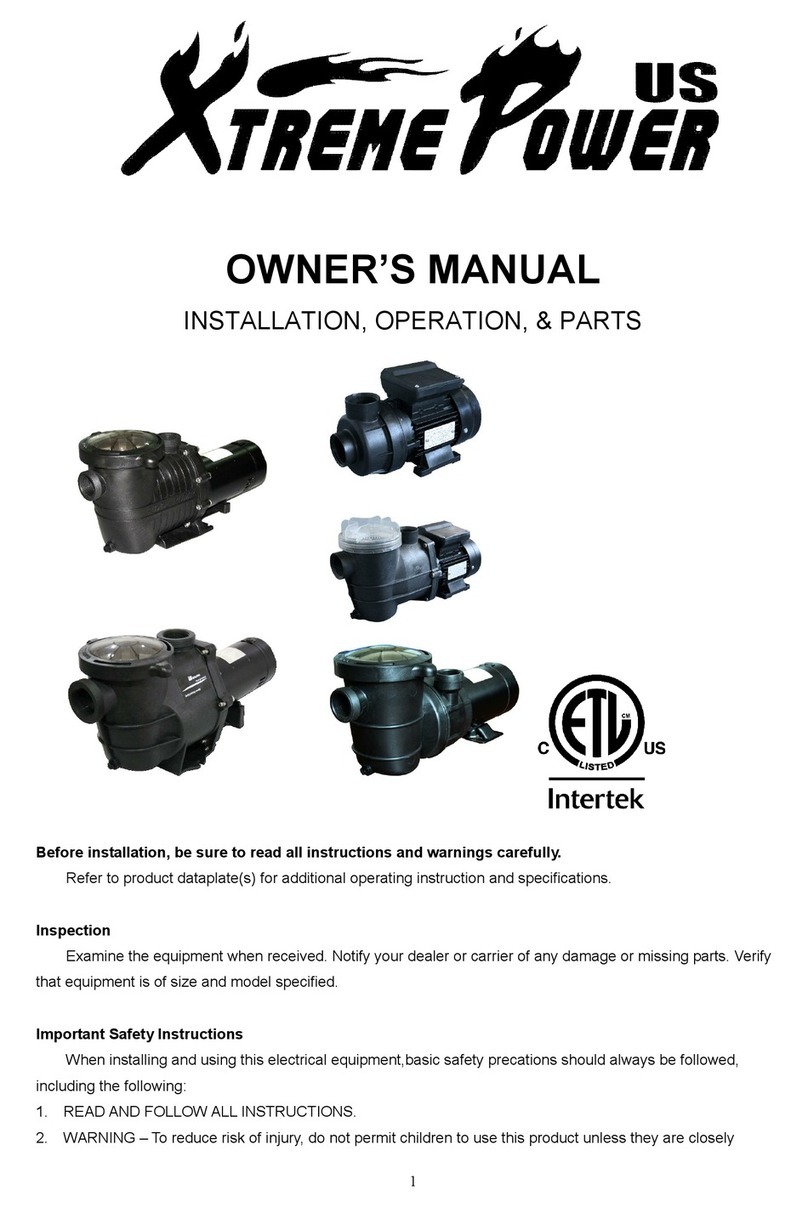
Xtreme Power
Xtreme Power 72712 owner's manual
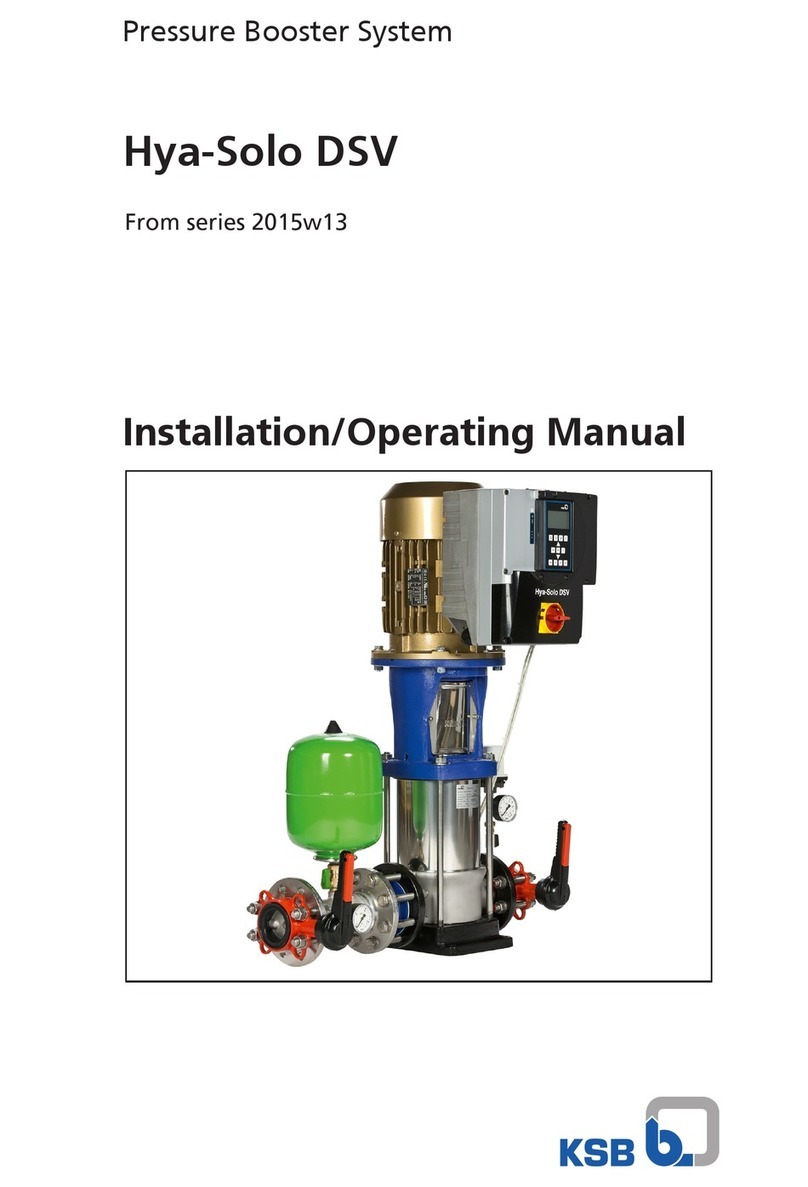
KSB
KSB Hya-Solo DSV Series Installation & operating manual
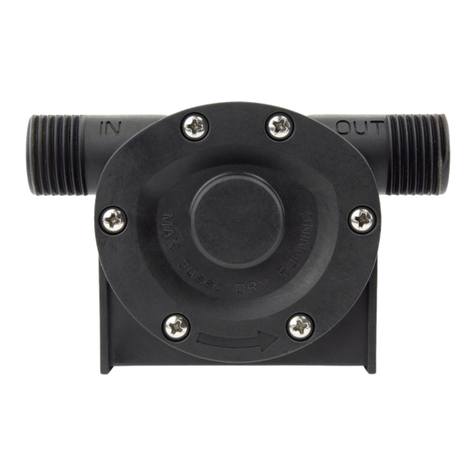
STAR Water Systems
STAR Water Systems 148178 instructions
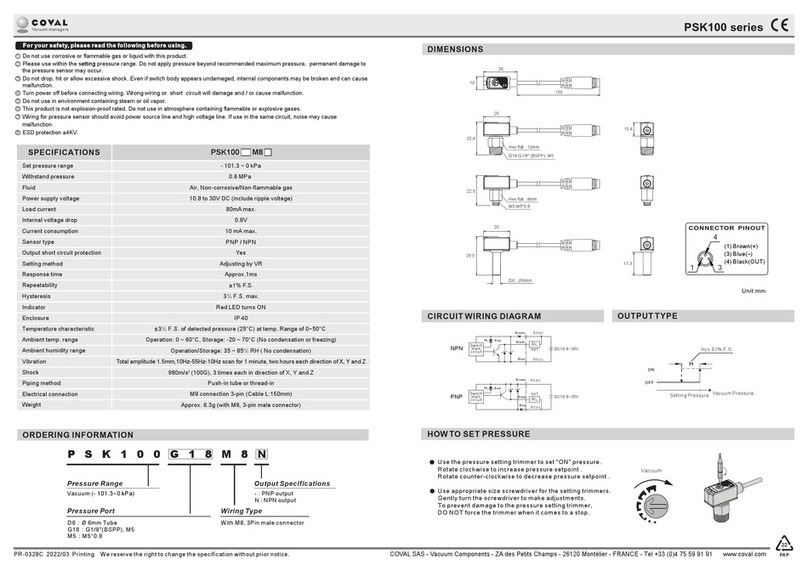
coval
coval PSK100 Series quick start guide

Elektro Maschinen
Elektro Maschinen PREMIUM LINE WPEm 5550/24G Operating instruction
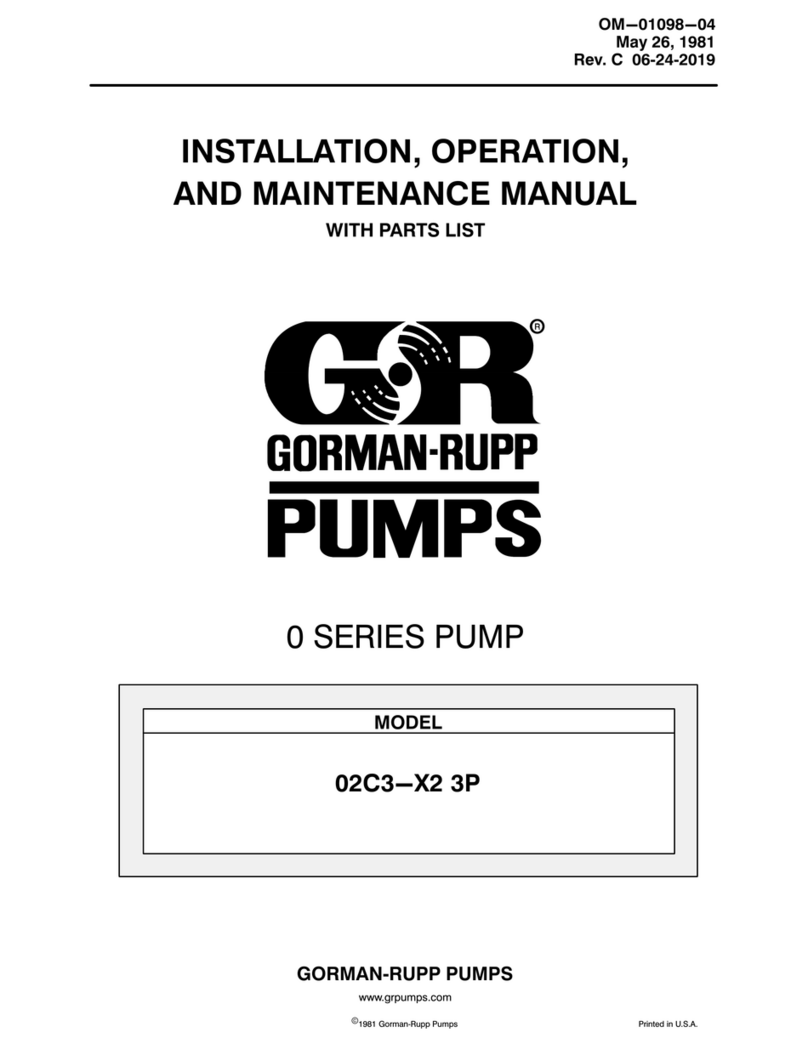
GORMAN-RUPP PUMPS
GORMAN-RUPP PUMPS 02C3-X2 3P Installation, operation, and maintenance manual with parts list

